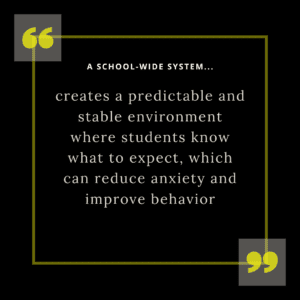Welcome to the second installment in our series on improving classroom management practices in your school. In our previous post, we discussed the importance of gaining teacher buy-in for effective classroom management. Now, we will explore how to create a cohesive, school-wide classroom management system that ensures consistency and supports equitable learning opportunities for all students.

The Importance of a School-Wide Approach
A school-wide classroom management system provides a unified framework for addressing student behavior and promoting a positive school culture. When every teacher and staff member follows the same set of guidelines and expectations, it creates a consistent environment where students understand the rules and expectations regardless of which classroom they are in. This consistency is crucial for students, especially those who may struggle with changes in routine or authority figures.
Steps to Develop a School-Wide Classroom Management System

- Establish a Clear Vision and Goals The first step in creating a school-wide system is to establish a clear vision and set of goals. What do you want your school culture to look like? What are the specific behavior expectations for students? Engage your leadership team, teachers, and other staff in discussions to develop a shared vision that reflects your school’s values and mission.
- Involve All Stakeholders Involving all stakeholders in the development process is crucial for buy-in and successful implementation. This includes not only teachers but also support staff, parents, and even students. Create committees or working groups that represent the diverse perspectives within your school community. Solicit feedback and ideas through surveys, focus groups, or town hall meetings.
- Develop Clear and Consistent Rules and Expectations Once you have a vision and goals, develop a set of clear and consistent rules and expectations that apply to all students and staff. These rules should be simple, positive, and focused on promoting a safe and respectful learning environment. For example, instead of saying “No running in the hallways,” frame it positively as “Walk calmly in the hallways.”
- Create a System for Teaching and Reinforcing Expectations It’s not enough to just establish rules; you must also teach and reinforce them consistently. Develop a plan for teaching behavior expectations at the beginning of the school year and revisiting them regularly. This could include lessons during homeroom, assemblies, or integrated into the curriculum. Use positive reinforcement to encourage good behavior, such as praise, rewards, or recognition programs.
- Provide Professional Development and Support Ensure that all staff members are equipped with the skills and knowledge to implement the school-wide system effectively. Provide professional development on classroom management techniques, behavior intervention strategies, and the importance of consistency. Offer ongoing support through coaching, mentoring, and regular check-ins.
- Monitor and Adjust the System Regularly monitor the effectiveness of your school-wide classroom management system and make adjustments as needed. Use data from behavior reports, teacher feedback, and student surveys to identify areas for improvement. Be willing to make changes and involve stakeholders in the process to ensure the system remains effective and relevant.
The Benefits of a School-Wide System

A school-wide classroom management system offers numerous benefits. It creates a predictable and stable environment where students know what to expect, which can reduce anxiety and improve behavior. It also fosters a sense of community and shared responsibility among staff, as everyone works together towards common goals. Ultimately, a consistent approach to classroom management can lead to improved academic outcomes, better social-emotional development, and a more positive school climate.
Implementing a school-wide classroom management system is a powerful strategy for promoting consistency and supporting student success. By establishing a clear vision, involving all stakeholders, and providing ongoing support, you can create an environment where all students have the opportunity to thrive. Stay tuned for the next blog in our series, where we will dive deeper into specific strategies for maintaining and reinforcing your school-wide system through consistent implementation.
